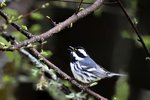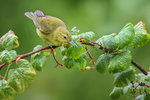

Warblers are smallish insect-eating songbirds that inhabit various areas in Thurston County. They are very active and all about the same size and shape. Not surprisingly, they are known for and often identified by their greatly differing songs (they’re warblers, after all). By mid-April, most migrating warblers will have arrived.
We have nine warbler species in the county, and that’s typical for most of the Pacific coast west of the Cascade crest. That may seem like a lot, but it’s only a small fraction of the 42 warbler species that call North America home, at least for the summer. The common names of our warbler species are interesting, and frustrating. Some tell you what they look like – Yellow Warbler, Common Yellowthroat, Black-throated Gray Warbler, Yellow-rumped Warbler. And some tell you almost nothing – Hermit Warbler, Wilson’s Warbler, Townsend’s Warbler, MacGillivray’s Warbler.
One of our locals, the Orange-crowned Warbler, would seem to fit with the first group, except that those orange crown feathers of the male are almost never actually visible. Except for those crown feathers, both sexes are a non-descript greenish-yellow with an olive back. They are fairly common on forest edges and have an interesting song, a fast trill that rises then descends in pitch. They sing off and on throughout the day.
Many of the other warblers are easy to identify if you study their songs a bit. The Wilson’s Warbler inhabits wet overgrown areas in or near woodlands. These birds are predominantly yellow, and the male has a prominent black cap. To me, his song sounds like he is grunting out the same note in a slow trill. The Black-throated Gray Warbler is a beautiful bird – Liam’s photo captures a singing male perfectly. His singing notes are few and ascend in pitch.
Most warblers arrive here in spring when their insect prey becomes common. They utilize this abundance to build up their strength for breeding and, eventually, to feed their young. The males sing, presumably both to declare a feeding territory (to discourage other males from trespassing) and to attract a female.
Some of you have written asking for help in identifying birds. Again, I want to emphasize that it’s not necessary to identify species to enjoy and appreciate our birds. However, for those who want to work on the identification puzzle, here are a couple suggestions to add to my recommendation in a previous column to pay attention to habitat.
When I’m looking at a bird, one of the first things I check out is its bill. It turns out that bills (some people call them beaks – same thing) can tell us a lot. Warblers, for example, have pointed bills, typical of insect and spider catchers. Contrast that with the thick stubby bill of a sparrow or a finch, both seed eating species. Of course, the bills of some species seem to be a compromise between the two extremes and, not surprisingly, many of these species have varied diets.
Now, here’s another trick that sometimes works to bring those small hard-to-see birds closer. It turns out that many of the small birds respond to a generalized alarm call that you can imitate. I usually make an emphatic “pssh;” others prefer a “shhh.” This works for birds like the warblers and may bring that singing male you are listening to right up close.
Next week I’ll write a bit about binoculars, that stereotypical appendage attached to bird watchers. They are not essential, but they do make solving those i.d. puzzles a bit easier.
George Walter is the environmental program manager at the Nisqually Indian Tribe’s natural resources department; he also has a 40+ year interest in bird watching. He may be reached at george@theJOLTnews.com
Photos for this column are provided by Liam Hutcheson, a 14-year-old Olympia area birder and avid photographer.
2 comments on this item Please log in to comment by clicking here
Drutty
am really enjoying your articles and the return of the birds~!
Thursday, April 21, 2022 Report this
johngreen
Your articles are for the birds
Saturday, April 23, 2022 Report this